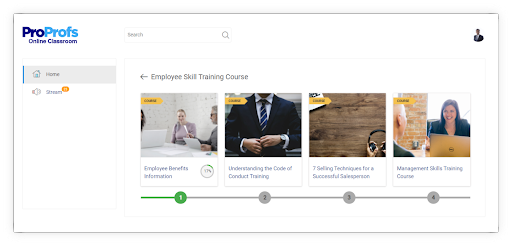
Online assessments are revolutionizing learning by making it more measurable and actionable.
They can play a significant role in learning paths.
How?
You can add quizzes or assessments at the end of each chapter to track learner progress and make them mandatory for learners to pass each test to unlock the next chapters.
By harnessing the potential of online assessments in learning pathways, learners will no longer be lost in a sea of information. Instead, they embark on structured routes to success.
So, if we’ve piqued your interest, let’s uncover how online assessments can shape learning pathways for better results, understand their types, how you can create learning pathways to educate or train people, and some real-life examples.
Let’s dive right in.
What Are Learning Pathways?
Learning pathways are a group of modules, tests, and activities tied together and assigned according to a predefined route. In other words, these are a structured approach to learning which is designed to meet personalized learning needs.

These paths show the correct order in which a learner should learn. Structured learning promotes better knowledge retention and learner satisfaction. In fact, it’s one of the most powerful features you must utilize in a Learning Management System (LMS).
These pathways work best with other e-learning practices, such as microlearning, blended learning, and mobile learning.
In the following section, we’ll help you better understand how online assessments make your learning paths more effective.
Read: What Is a Learning Path?
Role of Online Assessments in Learning Pathways
As an essential part of learning pathways, assessments benefit both learners and instructors. These assessments provide a barometer for learners’ progress and help measure their knowledge and skills against set criteria.
1. Creation of IDPs and Learning Paths
Assessments play a huge role in developing learning paths and Individual Development Plans (IDPs), which further help learners work through their career goals through practical steps and constant performance reviews.
For instance, you can identify skill gaps through pre-training assessments.
Based on the assessment reports, you can understand what topics you must include. Accordingly, you can develop courses and bundle them to guide progress and improvement by meeting the learner’s expectations. In short, assessments make it easier to design effective learning paths.
2. Ensuring Completion of Each Module
Since each learning path has a set of courses, adding end-of-chapter quizzes can help you understand how well your learners have grasped the materials. Also, by setting a passing grade for each module, you can ensure that learners retain maximum information before they proceed to the next chapter.
Read: How to Create and Set Up a Series of Quizzes for Your Learners
3. Assessing Knowledge Retention
E-learning quizzes help track and evaluate learners’ understanding, retention, recall, and progress. Assessments placed at the end of a chapter or course are usually graded. With some LMSs, you can automate quiz scoring and manually add points to individual questions.
Embedding quizzes at the end of learning paths helps review the points they’ve earned throughout the course, and it helps you understand how well your learners have retained knowledge.
This way, online assessments let you test your learners anytime, anywhere and provide instant grading and feedback.
Watch: How to Automate Quiz Scoring & Grading
By now, you must’ve understood how assessments play an integral role in creating learning paths and assessing knowledge.
But have you ever created learning paths? Did you use assessments to create learning paths or evaluate learner progress?
If not, then don’t worry! We’re here to help.
But before we get to the creation part, let’s understand the following.
Types of Learning Pathways
Based on how they are created, learning paths are basically of two types:
Sequenced (Linear)
A sequenced learning path is one where learners are enrolled on a path containing several courses, assessments, or other activities in chronological order. After completing each module or assessment, the learner is automatically assigned the next one. In sequenced learning, learners must complete all the courses or assessments to complete a path.
Who should use this path: Ideal for those who want to build a structured learning program with a group of courses or assessments that has to be mastered within a certain time period.
Sequenced learning is the best option when the courses increase in difficulty or mastery level. These paths can be on different subjects.
Learning Paths With Learner Choice (Non-Linear)
A non-linear learning path provides high learning flexibility. Some courses, assessments, or activities in this path are compulsory, and some are optional. In this type, you let learners control their learning and complete the modules in the order they want to take them.
Pro Tip: Use this learning path when the learning order isn’t important. This will empower learners to choose their learning route.
Here, you provide learning choices to your learners without compromising the objectives or goals. This path focuses on learning flexibility and outcome rather than the order of learning.
These are the two types of workplace learning pathways. Choose the one that best meets your learners’ needs and training goals.
5 Steps to Create Effective Learning Pathways
To develop the best learning pathways, you must follow some best practices. It starts with analyzing training needs and ends with sharing feedback.
Let’s go through each step in detail.
Step 1: Analyze Training Needs and Identify Knowledge Gaps
Creating a learning path starts with analyzing training needs. Once you analyze the needs, it becomes easier to identify the existing knowledge and gaps. Based on this finding, you can understand which topics you should include in your learning pathway.
Pro tip: Conducting pre-training assessments can help identify skill gaps and evaluate the candidates on the necessary criteria.
Read: How to Conduct a Training Needs Assessment in Your Organization
Step 2: Create Engaging Courses
Once you’ve analyzed the training needs and identified the gaps, it’s time to create your courses.
You can use readymade courses and premade templates available within an LMS or upload existing documents, images, videos, PPTs, and recorded webinars.
Make sure you add engaging elements to your courses, like videos, labeled graphics, flashcards, games and quizzes, to keep your learners motivated and engaged throughout the learning journey. This will also help them connect with your content in a better way.
To know more about course creation, you can check out this guide.
Watch: How to Create an Online Course
Step 3: Implement Your Learning Path
This is where you’ll roll out your learning path. To do this, you need to find the best LMS to deliver your program. Ideally, you should use an LMS with built-in learning path features to bundle your courses in order of complexity, boost learning efficiency, and offer personalized experiences.
The LMS you choose should facilitate guided learning and let your learners collaborate at every learning point to solve problems.
Check out this video guide to help you with this:
Watch: How to Choose the Best SaaS LMS Software
Step 4: Add Assessments & Track Progress
It’s important to add assessments to your learning paths, so that you can track learners’ progress, milestones, and challenges. This is where post-training assessments can help.
Embed online quizzes at the end of each module to understand your learners’ mastery. With the best LMS, you can prevent skipping questions and let learners record video responses as well.
You can also pull out auto-generated reports to track learner progress and share them through email. You may also provide live access to the report page. Quiz reports help monitor individual and group progress, course engagement levels, and pending courses.
Post-training assessments provide a holistic view of your training program from the learner’s perspective, which is essential to understand what works for your learners and what doesn’t.
Here’s a quick tutorial on creating such assessments in the easiest way possible:
Watch: How to Create an Online Quiz in Under 5 Mins
Step 5: Share & Collect Feedback
Based on the assessment reports, you should provide feedback to your learners on how well they have performed and the areas that require improvement.
Remember, feedback is a two-way process. You should also enable your learners to share feedback to improve your learning paths.
How can you do that?
Add short and engaging online surveys!
Read: How to Set up a Learning Path for Your Learners
What Are the Benefits of Learning Pathways?
Today, upskilling and reskilling learners have become more important than ever due to a competitive market. For learning to be effective, it should be engaging, convenient, and personalized. Workplace learning pathways can help you meet these goals.
With learning paths and their delivery through an LMS, educational institutions and business organizations can provide flexible learning opportunities that would benefit them and their learners.
So, if you want to understand in detail the benefits of learning paths, continue reading.
Benefits For Employers
Learning paths offer several advantages for employers, helping them achieve their organizational goals and objectives more effectively.
Adds More Structure to Your Training Programs
By adding a sequential order, learning paths show the right pathway to learning so that learners
can gain mastery of a particular topic or subject. Training becomes more structured with learning paths and can address multiple learners’ needs.
Structured training programs give you the ability to control the order of the courses, quizzes, or activities in which they get assigned. They also provide administrators the ability to determine the duration within which learners must commence or complete a path.
Saves Instructors Time & Effort
Learning paths greatly benefit instructors by saving their valuable time and reducing effort.
Wondering how?
Instructors can enroll multiple learners at a time and assign them predefined pathways so that they can learn at their chosen pace. Since there’s a pre-planned learning route for achieving the intended goals, learners can learn at their chosen schedule.
This reduces the burden on the instructors as they don’t have to unnecessarily conduct regular check-ins, modifications, and updates to how learners are learning.
When learners complete a course, assignment, or activity, they’re automatically enrolled in the next based on the results without the instructor’s intervention.
Promotes Continuous & Effective Feedback
Training alone won’t help learners acquire knowledge and skills. There should be a proper feedback process where they can continuously understand how well they have learned the information. This will also help you track the learning progress and ensure that your learners are on the right track.
So, how can you track progress?
Use online assessments in your learning paths!
You can view the assessment reports and analyze how well your learners have grasped each chapter.
Watch: How to Review Quiz Reports & Statistics
Helps to Achieve Organizational Goals and Objectives
By implementing learning paths, employers can align the skills and knowledge acquired by their employees with the specific goals and objectives of the organization. This targeted approach ensures that employees gain the expertise required to contribute towards the company’s success.
- Increases Employee Engagement
Learning paths provide a structured framework for employee development, which fosters a sense of purpose and engagement. When employees have clear learning objectives and a roadmap for advancement, they are more likely to be motivated and invested in their work.
- Improves Employee Retention
Investing in learning paths demonstrates a commitment to employee growth and development. This, in turn, increases employee loyalty and reduces turnover rates.
When employees see opportunities for advancement within the organization, they are more likely to stay and contribute to their organizations in the long term.
- Enhances Long-Term Productivity
By providing employees with a clear path for learning and development, organizations can enhance long-term productivity.
Learning paths ensure that employees are equipped with the necessary skills and knowledge to excel in their roles. This, in turn, leads to increased efficiency, improved performance, and ultimately, higher productivity levels.
Benefits For Employees
Learning paths offer numerous benefits to employees as well, empowering them and enabling them to take control of their learning and career development.
- Facilitates Self-Paced Learning
Different employees have different learning styles and preferences, and the ability to retain information varies from individual to individual. Without learning paths, they have to stick to the same pace, which may make learning inconvenient and counterproductive.
The good news is that learning paths enable self-paced learning so that learners can choose what, when, how, and where they want to learn.
- Better Engagement & Knowledge Retention
A lack of engagement makes learning burdensome and mechanical. This is where learning paths can help. They’re a great way to motivate learners and keep them engaged, from start to end. They help deliver knowledge in small bites in an organized manner.
Small information chunks help in knowledge retention and reduce cognitive load on learners.
This case study also highlights the same.
And the best part?
Learners progress toward bigger goals at their chosen pace, which keeps them motivated.
Pro Tip: Make your learning paths as engaging as possible. For instance, if you are adding online quizzes, try incorporating different question formats like MCQs, checkboxes, true & false, matching, fill in the blanks, etc. Make your quizzes more appealing by adding images and videos to your questions and answers.
Watch: 15+ Question Types for Online Learning & Assessment
- Puts Learners in Control of Their Learning
One of the biggest benefits of online learning pathways is that these enable choice-based learning where learners can decide the order and pace of learning. This control over the learning choice produces better results as learners acquire knowledge according to their needs and experience levels.
Custom learning paths empower learners. They achieve learning objectives with full control along the way.
- Boosts Employee Morale
When employees get opportunities for upskilling in an organized way, they feel valued and supported by their organization. This boosts their morale and creates a positive work environment.
Employees appreciate the opportunity to expand their knowledge and skills, which contributes to their overall job satisfaction.
- Helps Achieve Long-Term Career Goals
By following a learning path, employees can strategically acquire the skills and knowledge necessary to achieve their long-term career goals.
Learning paths provide a roadmap for progression, ensuring that employees are equipped with the right competencies to advance in their chosen career path.
- Improves Employees’ Sense of Value
When organizations invest in learning paths, they communicate to employees that their growth and development are a priority.
This recognition fosters a sense of worth and appreciation among employees. They feel that their contributions matter and that the organization is invested in their success, which strengthens their commitment and loyalty.
Examples of Learning Paths With Assessments
To further stress the importance of adding assessments to learning paths, let’s discuss a few examples to show how companies use assessments to track learner progress.
Employee Learning Pathways
Education is vital for building an efficient and productive workforce, encompassing various aspects such as employee onboarding, compliance training, and upskilling.
Employee learning paths offer a valuable opportunity to take a targeted and streamlined approach to learning. One of the significant benefits of implementing a learning path is the reduction in administrative tasks associated with employee education.
Rather than enrolling employees in individual courses, you can simply include them in a learning management system and allow the learning path to guide their development and progression.
This streamlined approach saves time and effort in managing the educational process for each employee.
Example 1: Acer
Acer, one of the leading tech companies, was looking for a solution that would enable it to train and certify its employees on new product releases.
It needed a powerful assessment tool for its training program to track learning progress and certify the learners.
That’s when Acer used an assessment software that automatically graded the tests and pulled out detailed reports on learner progress.
Read more about the success story here.
Example 2: Fire Department of San Diego
The City of San Diego’s Fire-Rescue Department used an assessment tool to digitize its training process. The department was particularly looking for a solution with features like question banks, grading, and feedback options.
According to the training coordinator, trainees were happy to take the assessments and enjoyed the instant feedback mechanism.
Read more about the success story here.
Learning Pathway for Onboarding Partners
Smooth collaboration between partners is imperative to boost sales and expand your business. For this, your partners should be thoroughly educated on your industry, business, and products & services.
Thus, educating them via a learning path with online assessments and quizzes will familiarize them with your brand and enhance their product knowledge while ensuring consistent compliance.
When it comes to educating partners, a learning pathway with assessments allows you to efficiently achieve crucial onboarding objectives, which include:
Gaining insights into partners’ strengths and areas for improvement. This knowledge helps you tailor your support and resources to address their specific needs effectively.
Equipping partners with the necessary support for successful product sales. This accessibility enhances their ability to represent your brand accurately.
Providing comprehensive brand training: This training covers critical aspects such as brand values, messaging, and positioning, empowering partners to effectively communicate your brand’s unique identity to customers.
Gathering valuable feedback from partners. This feedback is crucial to fine-tune your educational programs, identifying areas for improvement, and fostering stronger relationships with your partners.
Online Assessments & Learning Pathways: Your Way To Effective Learning
We hope by now you know how you can leverage online quizzes and assessments for your learning pathways.You can simply follow the easy steps to create learning pathways using ProProfs Quiz Maker and embed online assessments in your audience’s learning journeys.
Besides, you can create quizzes using the AI quiz generation feature that helps you create quizzes
Doing so will make learning more engaging and help educators tailor their teaching strategies for maximum impact.
Frequently Asked Questions
Why should I use assessments in learning paths?
Assessments help identify skill gaps, based on which you can decide on the topics for your learning path. Similarly, adding assessments to your learning paths can help learners unlock chapters progressively, and you can evaluate their progress based on specific benchmarks.
What is an example of a learning path?
A learning path could be a step-by-step curriculum designed for individuals interested in learning web development. For example, a learning path for coding languages may start with basic HTML and CSS, gradually progressing to more advanced topics such as JavaScript, responsive design, and backend development.
What is the objective of a learning path?
The objective of a learning path is to guide learners in acquiring specific skills, knowledge, and competencies in a structured and organized manner. It provides a clear roadmap for individuals to follow, ensuring they progress systematically and effectively toward their desired learning goals.
What is a learning path in education?
In education, a learning path is a personalized journey for students to achieve specific outcomes. It involves sequencing activities, resources, and assessments to support progress. Learners follow a prescribed route, combining instruction, study, exercises, projects, and assessments.
What is the best way to create a quiz for learning paths?
There are two simple ways to create a quiz for this purpose – you can use your existing questions and create your quiz from scratch, or you may leverage the professionally designed quiz templates and question banks available in top LMS software. To know more, you can read this guide.
Do you want free Quiz Software?
We have the #1 Online Quiz Maker Software for complete learning & assessment





